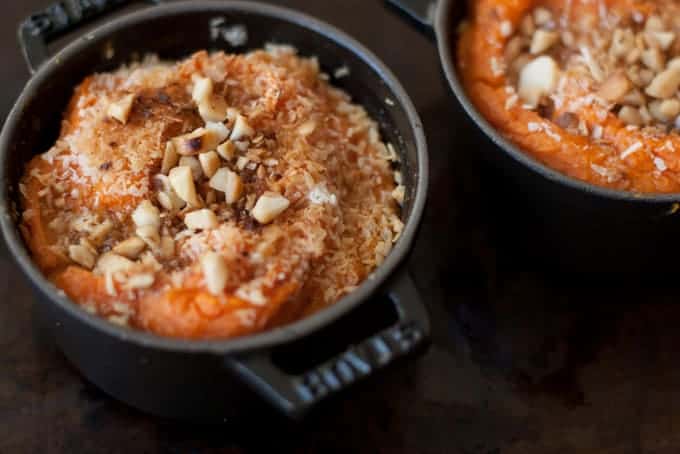Recipes
Sourdough Buckwheat Bread
If you ever make it to the Ariege region, my favorite corner of France, you absolutely must reserve some time to enjoy the Thursday market at La Bastide-de-Sérou. While there are larger, busier and more extravagant markets to be found, I love La Bastide’s because it is not any of those things. It has a…
Read MoreSaffron Fennel
Whether you are a fennel fan or not, this recipe is a must for veggie lovers. Enjoy this dish warm, right out of the oven, or at room temperature. Ingredients 2 large or 4 small fennel bulbs 1.5 cube of vegetable bouillon dissolved in 3/4 C boiling water 3 large pinches saffron strands 1 Tbsp…
Read MoreSweet Potatoes with Coconut and Macadamia Nuts
We have all observed a steady evolution of holiday side dishes over the past decades, and sweet potatoes are no exception to the rule. For good reason, most of these evolutions have cut out the refined sugars and dairy products, increasing the use of whole, fresh vegetables. Especially if your holiday memories are of sweet…
Read MoreRoasted Delicata Squash Salad
The months of November and December are a perfect time for sharing with others the goodness of plant-based eating. Trust me, your gorgeous veggies will always be the first to go, hands down, at every holiday gathering, whether it is at your aunt’s house or the office. So don’t be shy! Show your stuff this…
Read MoreVegan Dal Makhani
Ingredients 1 cup dry whole urad dal (black lentils), debris removed and soaked in plenty of water overnight or for at least six hours 4 cups water 15 oz can kidney beans (1 1/2 cups), drained and rinsed 3 tbsp coconut oil or vegan butter 1 tsp cumin seed 1 small bay leaf 4-6 cloves…
Read MoreBest Ever Black Bean Soup
This week I am happy to share a recipe from an Austin friend and outstanding vegan chef, Anna Fry. Anna passed along this recipe ages ago when our then-preteens enjoyed this soup for lunch at her home during a school holiday. It still a top request at the Hubele home when soup season rolls around. …
Read MoreBlack Bean and Butternut Squash Stew
Is it simmering stew season yet? Just to be clear, that means a veggie-full stew, and this one totally fits the bill. Not only is it packed with fall harvest vegetables, the spice combination is divine. I brought this along to a house concert potluck, and I had to think twice if I really wanted…
Read MoreCleansing Kitchari
If you haven’t tried Kitchari, now is the time. The traditional Ayurvedic cleansing meal is perfect for fall. If the ingredients listed aren’t readily available or you aren’t up to tracking down the spices, you can simply order this kit from Banyan Botanicals and get started. Be sure to plan for a large batch as this…
Read MoreSpicy Chickpea Soup
I first made this recipe during a cold, wet March in Austin. The good news is, I happen to love soup and have an endless array of recipes to help us wait out these Austin-style cold fronts. My daughter Kate shared this recipe when she gifted me a jar of homemade harissa paste. While she…
Read MoreMushroom Spinach Soup with Cinnamon, Coriander and Cumin
Here’s my take on a yummy mushroom soup that appeared in a New York Times fall soup feature. I love the challenge of taking on conventional recipes and creating a vegan/gluten-free version — and this one is no exception. Although I rarely pass up a mushroom recipe, this one has a combination of cinnamon, coriander…
Read MoreWatermelon Gazpacho
You are going to love this recipe for its ease and flavor. This gazpacho is so good I could eat it for three meals a day… seriously. So what are you waiting for? Grab these ingredients, power up your blender and in minutes, your meal is ready! 4 large heirloom tomatoes, chopped and cored 6…
Read MoreRoasted Eggplant with Spiced Chickpeas
If you eat seasonally and live in Texas, late summer means eggplant, zucchini and peppers. And the best way to use this limited range of veggies is to get creative — something I don’t mind doing. This week, with a nudge from Julie Moskin, we enjoyed this gorgeous, Middle Eastern-inspired dish. Ingredients 3-4 narrow eggplants,…
Read More
